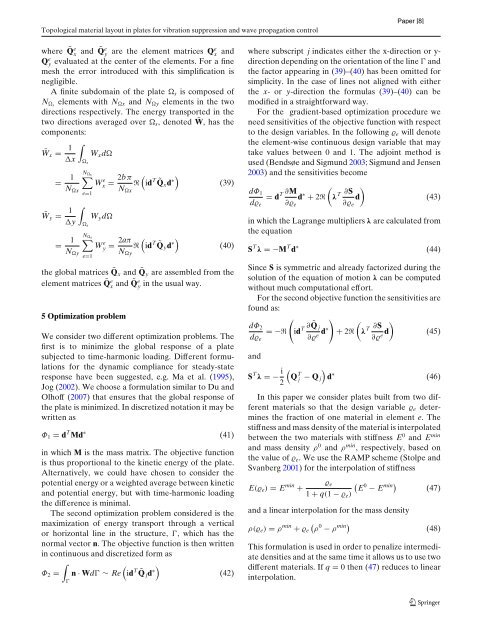WAVES AND VIBRATIONS IN INHOMOGENEOUS STRUCTURES ...
WAVES AND VIBRATIONS IN INHOMOGENEOUS STRUCTURES ...
WAVES AND VIBRATIONS IN INHOMOGENEOUS STRUCTURES ...
You also want an ePaper? Increase the reach of your titles
YUMPU automatically turns print PDFs into web optimized ePapers that Google loves.
Topological material layout in plates for vibration suppression and wave propagation control<br />
where ˜ Qe x and ˜ Qe y are the element matrices Qex and<br />
Qe y evaluated at the center of the elements. For a fine<br />
mesh the error introduced with this simplification is<br />
negligible.<br />
A finite subdomain of the plate s is composed of<br />
Ns elements with Nx and Ny elements in the two<br />
directions respectively. The energy transported in the<br />
two directions averaged over s, denoted ¯W, has the<br />
components:<br />
¯Wx = 1<br />
<br />
Wxd<br />
x<br />
= 1<br />
Nx<br />
s<br />
<br />
Ns<br />
W<br />
e=1<br />
e x<br />
¯Wy = 1<br />
<br />
Wyd<br />
y s<br />
= 1<br />
Ny<br />
<br />
Ns<br />
W<br />
e=1<br />
e y<br />
2bπ<br />
<br />
= ℜ id<br />
Nx<br />
T Qxd ˜ ∗<br />
2aπ<br />
<br />
= ℜ id<br />
Ny<br />
T Qyd ˜ ∗<br />
(39)<br />
(40)<br />
the global matrices ˜ Qx and ˜ Qy are assembled from the<br />
element matrices ˜ Qe x and ˜ Qe y in the usual way.<br />
5 Optimization problem<br />
We consider two different optimization problems. The<br />
first is to minimize the global response of a plate<br />
subjected to time-harmonic loading. Different formulations<br />
for the dynamic compliance for steady-state<br />
response have been suggested, e.g. Ma et al. (1995),<br />
Jog (2002). We choose a formulation similar to Du and<br />
Olhoff (2007) that ensures that the global response of<br />
the plate is minimized. In discretized notation it may be<br />
written as<br />
Φ1 = d T Md ∗<br />
(41)<br />
in which M is the mass matrix. The objective function<br />
is thus proportional to the kinetic energy of the plate.<br />
Alternatively, we could have chosen to consider the<br />
potential energy or a weighted average between kinetic<br />
and potential energy, but with time-harmonic loading<br />
the difference is minimal.<br />
The second optimization problem considered is the<br />
maximization of energy transport through a vertical<br />
or horizontal line in the structure, Ɣ, which has the<br />
normal vector n. The objective function is then written<br />
in continuous and discretized form as<br />
<br />
<br />
Φ2 = n · WdƔ ∼ Re id T Q˜ jd ∗<br />
(42)<br />
Ɣ<br />
where subscript j indicates either the x-direction or ydirection<br />
depending on the orientation of the line Ɣ and<br />
the factor appearing in (39)–(40) has been omitted for<br />
simplicity. In the case of lines not aligned with either<br />
the x- ory-direction the formulas (39)–(40) canbe<br />
modified in a straightforward way.<br />
For the gradient-based optimization procedure we<br />
need sensitivities of the objective function with respect<br />
to the design variables. In the following ϱe will denote<br />
the element-wise continuous design variable that may<br />
take values between 0 and 1. The adjoint method is<br />
used (Bendsøe and Sigmund 2003; Sigmund and Jensen<br />
2003) and the sensitivities become<br />
dΦ1 T ∂M<br />
= d d<br />
dϱe ∂ϱe<br />
∗ <br />
T ∂S<br />
+ 2ℜ λ d<br />
(43)<br />
∂ϱe<br />
in which the Lagrange multipliers λ are calculated from<br />
the equation<br />
S T λ =−M T d ∗<br />
(44)<br />
Since S is symmetric and already factorized during the<br />
solution of the equation of motion λ can be computed<br />
without much computational effort.<br />
For the second objective function the sensitivities are<br />
found as:<br />
<br />
dΦ2<br />
=−ℜ<br />
dϱe<br />
id T ∂ ˜ Q j<br />
d∗<br />
∂ϱe and<br />
S T λ =− i<br />
<br />
Q<br />
2<br />
T j − Q <br />
j d ∗<br />
<br />
T ∂S<br />
+ 2ℜ λ d<br />
∂ϱe (45)<br />
(46)<br />
In this paper we consider plates built from two different<br />
materials so that the design variable ϱe determines<br />
the fraction of one material in element e. The<br />
stiffness and mass density of the material is interpolated<br />
between the two materials with stiffness E 0 and E min<br />
and mass density ρ 0 and ρ min , respectively, based on<br />
the value of ϱe. WeusetheRAMPscheme(Stolpeand<br />
Svanberg 2001) for the interpolation of stiffness<br />
E(ϱe) = E min +<br />
ϱe 0 min<br />
E − E<br />
1 + q(1 − ϱe)<br />
<br />
and a linear interpolation for the mass density<br />
ρ(ϱe) = ρ min 0 min<br />
+ ϱe ρ − ρ <br />
(47)<br />
(48)<br />
This formulation is used in order to penalize intermediate<br />
densities and at the same time it allows us to use two<br />
different materials. If q = 0 then (47) reduces to linear<br />
interpolation.

















